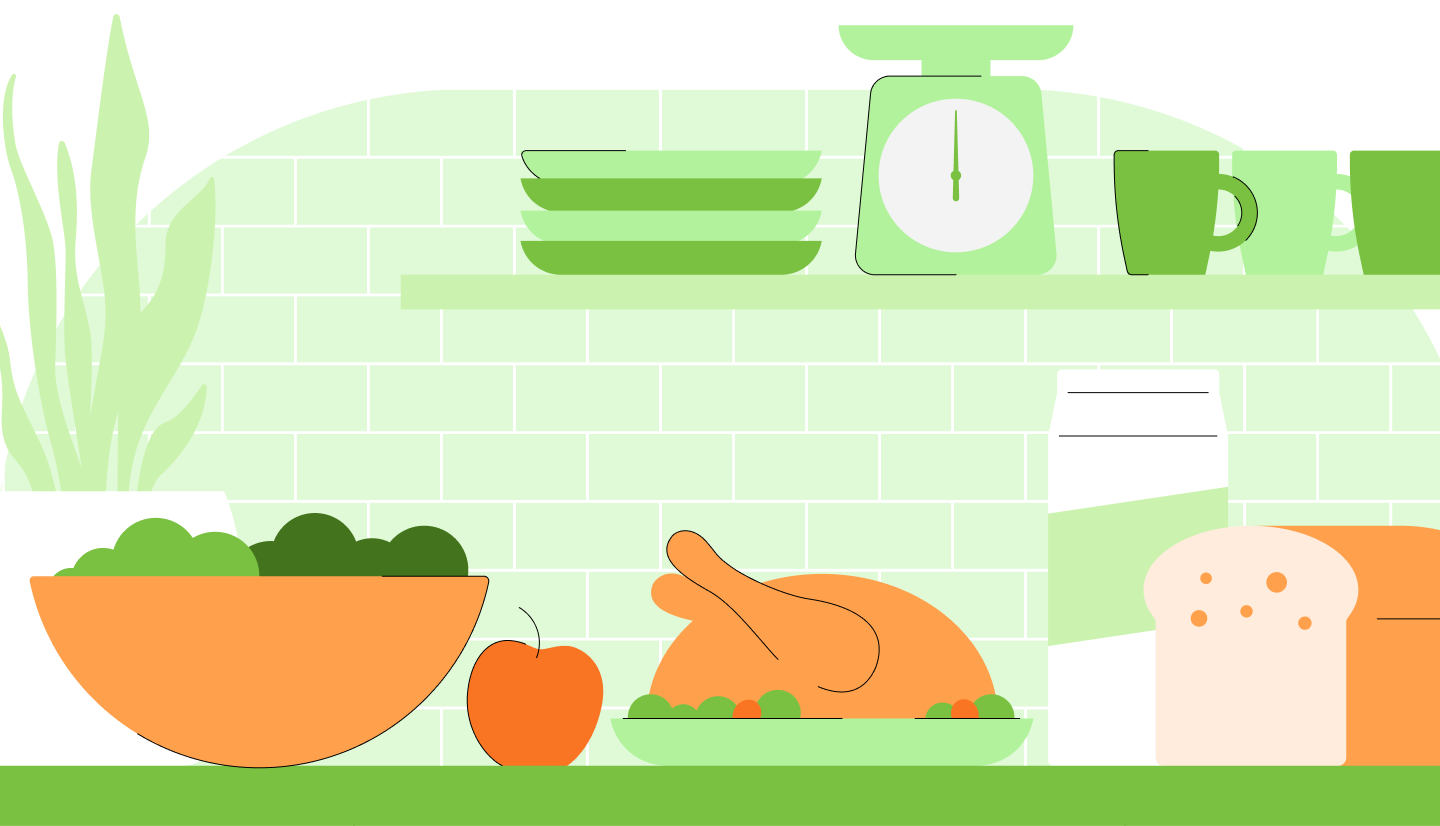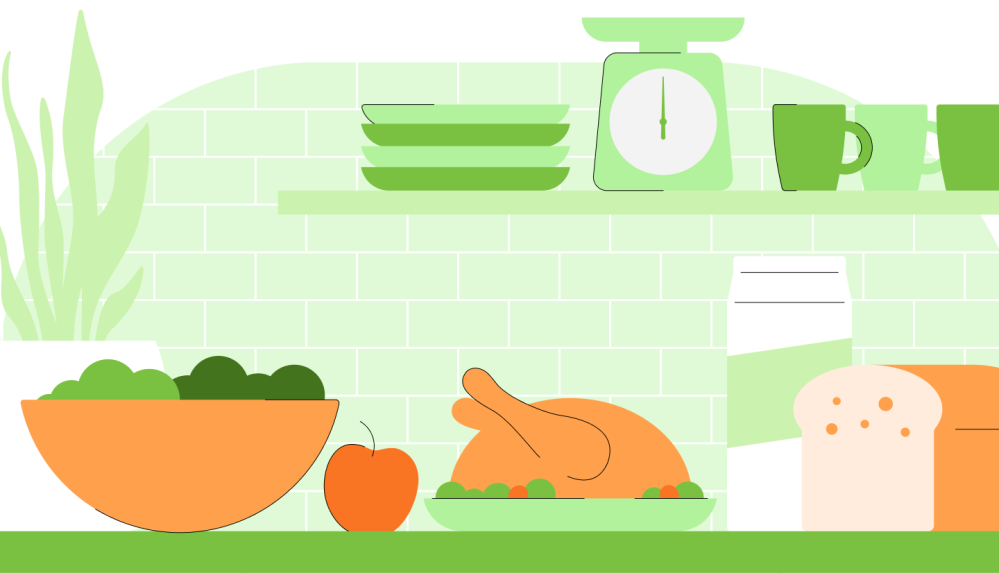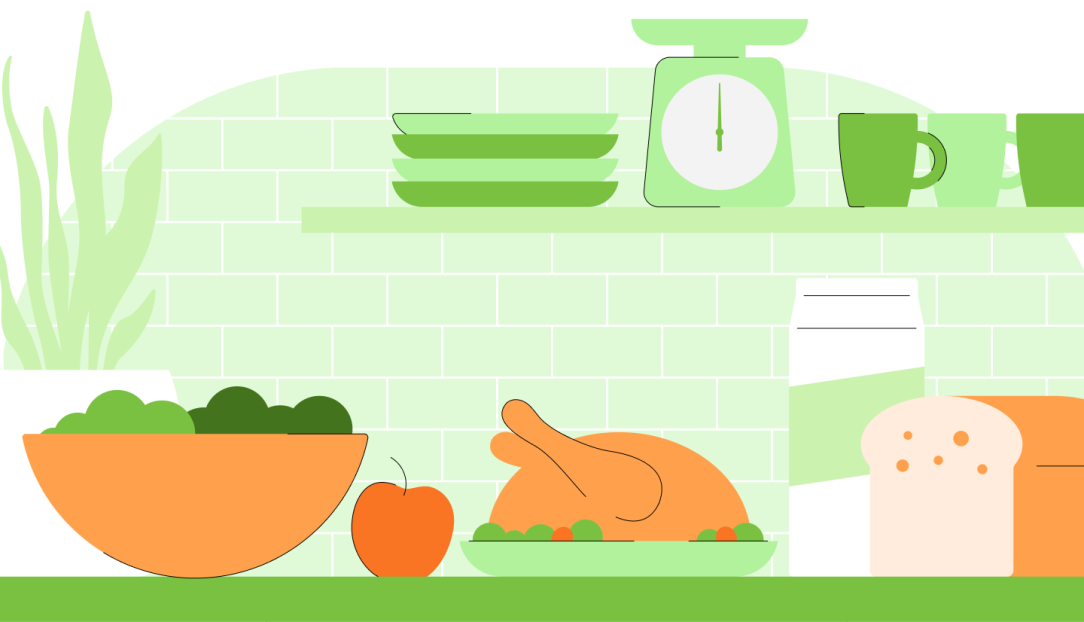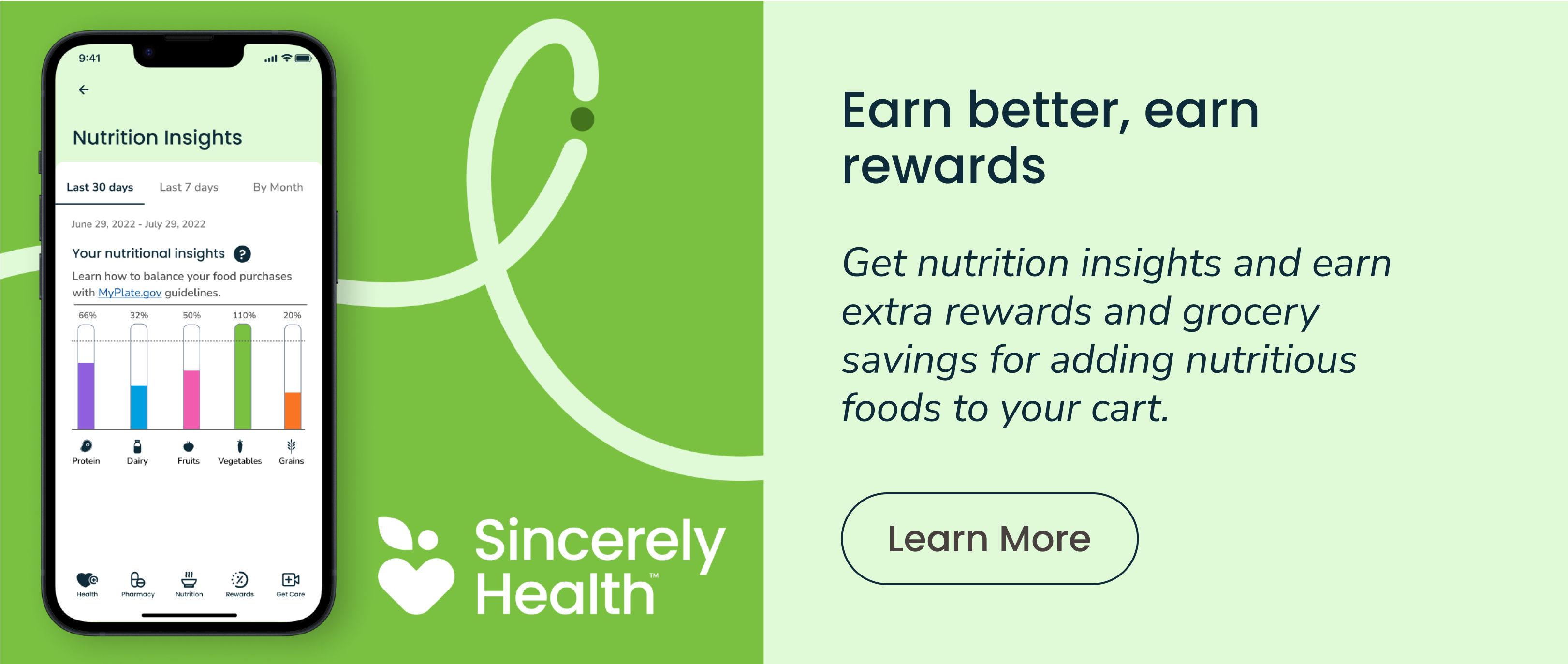Eating a balanced diet can seem challenging in today’s environment, but it’s an everyday habit you can pursue with the right tools, like USDA’s MyPlate. By using simple icons and symbols, MyPlate can help you build your plate based on the USDA-recommended serving of each MyPlate food group. This article will show you how the USDA’s MyPlate guidelines can help you eat better today.
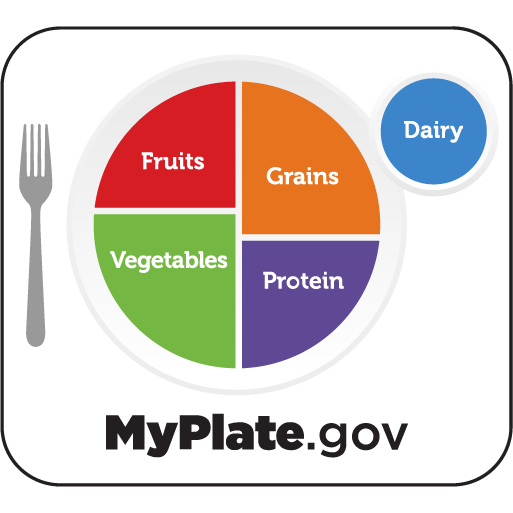
What is MyPlate?
Created in 2011 by the U.S. Department of Agriculture (USDA), MyPlate is designed to help Americans make healthy, balanced food choices that align with the Dietary Guidelines for Americans. The MyPlate daily food group targets are based on a 2,000 calorie plan, but nutrition needs vary based on your age, sex, height, weight, physical activity level, and health conditions. You can create your own personalized MyPlate Plan here. Always consult with your healthcare provider regarding your diet and healthcare needs.
Born out of Michelle Obama’s anti-obesity campaign, the MyPlate guidelines replaced the food pyramid with a new, simpler image of a plate divided into basic food groups.
The MyPlate icon shows a plate divided into sections that represent the five food groups:
- Fruits
- Vegetables
- Grains
- Protein
- Dairy
This visual representation encourages you to include a variety of foods in your meals. When planning your meals, knowing the MyPlate food groups and their proportions could be helpful. This simple guide suggests filling half your plate with various fruits and vegetables while dividing the remaining space between grains and protein-packed foods. MyPlate also recommends dairy, as represented by the glass symbol off the plate’s side.
MyPlate promotes healthy eating by recommending that half of your plate be filled with fruits and vegetables (with vegetables covering a larger portion of that half plate than fruits) and suggests focusing on whole fruits and getting a variety of veggies.
Elaine Magee, MPH, RD Wellness Corporate Dietician
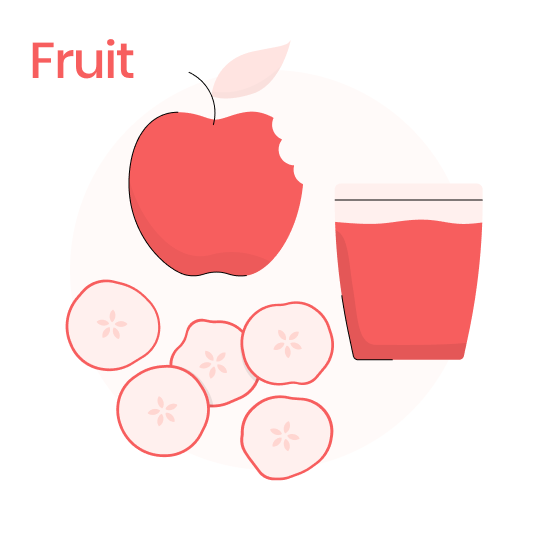
The MyPlate Fruit Food Group
You may wonder which foods qualify as “fruit.” The good news is that what you think of as “fruit” is probably right – but what constitutes a serving of fruit is debated. We’re here to make it as clear as possible.
According to MyPlate, the Fruit Group includes all fruits and 100% fruit juice – though USDA recommends that at least 50% of the recommended amount should come from whole fruit, a source of dietary fiber. You can have fresh fruit or frozen, canned, or dried. You can eat it whole, cut it up, mash it, or even cook it (think baked apples).
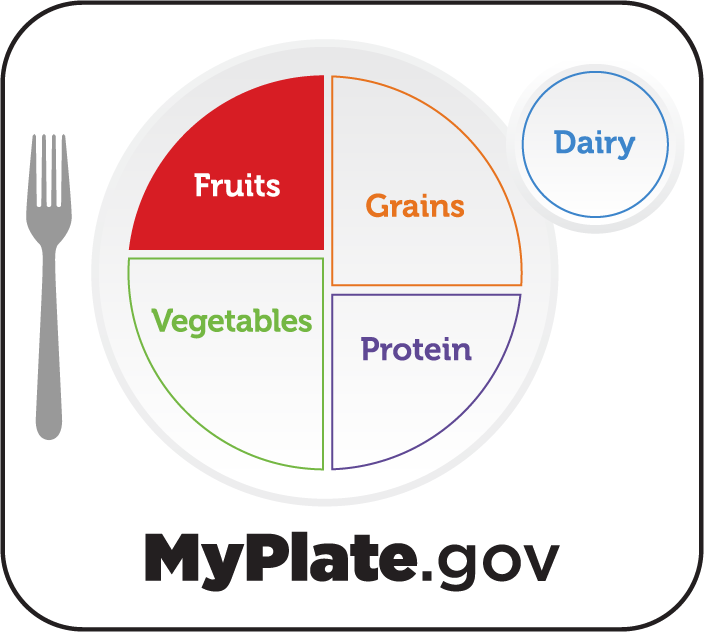
Daily fruit recommendations
What is one cup of fruit, you might ask? MyPlate says that the following equals one cup of fruit from the Fruit MyPlate group:
- One cup of fruit (fresh, frozen, canned)
- One-half cup of dried fruit
- One cup of 100% fruit juice
MyPlate gives general recommendations based on age and how much fruit you should get daily. The MyPlate guidance suggests that the amount of fruits you need daily depends on various factors like age, sex, and weight or whether you are pregnant, but here are the general guidelines for adults:
- For women ages 19 and older: 1 1/2 to 2 cups
- For men ages 19 to 59 years: 2 to 2 1/2 cups
- For men 60+ years: 2 cups
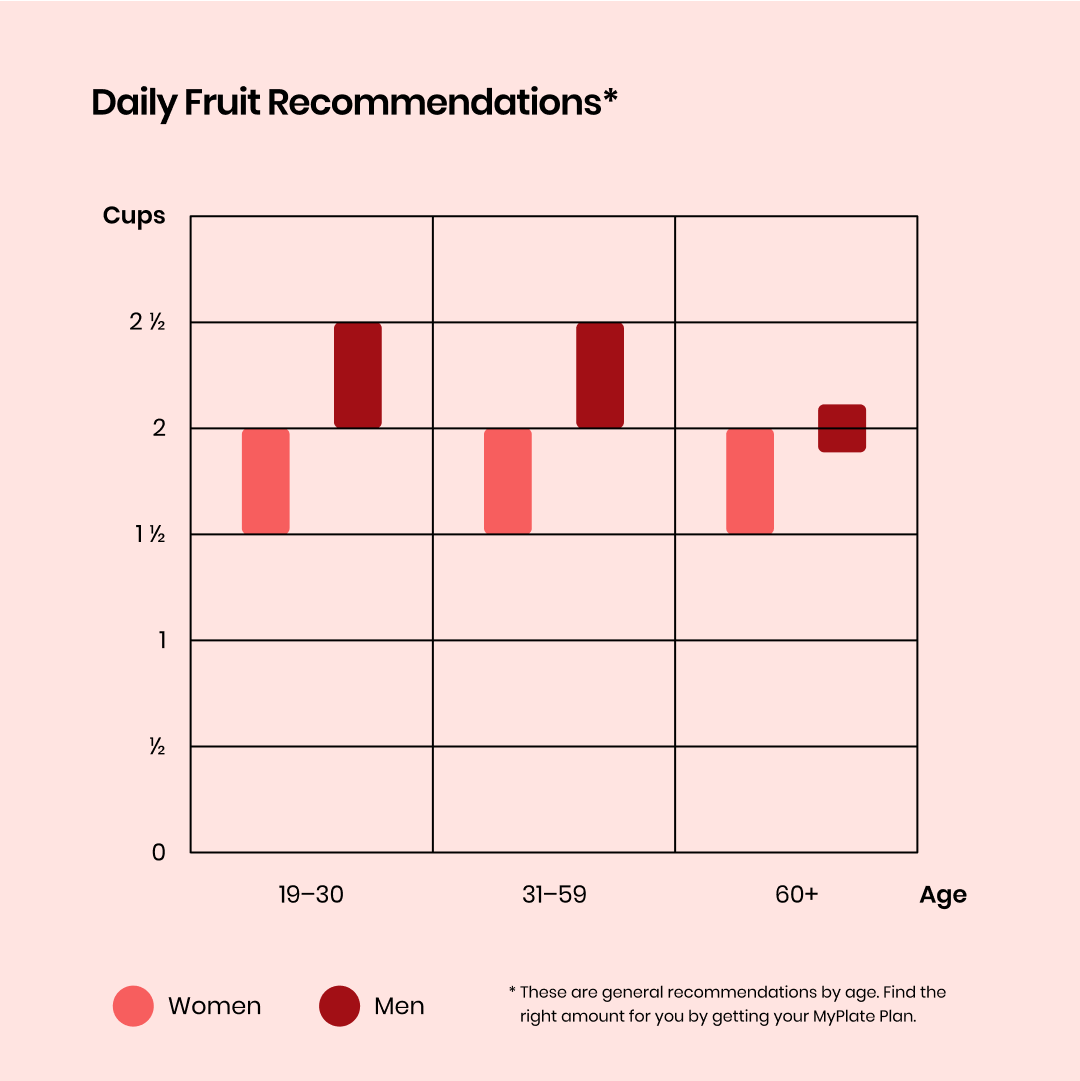
Source: U.S. Department of Agriculture, Daily Fruit Table
Examples of fruit servings
You probably already have a list of your favorite fruits, but here is a list of the top 7 U.S. fruit choices as of 2021 for inspiration and the amount of each that amounts to 1 cup according to MyPlate:
Apples:
- 1 small apple
- 1 half of a large apple
- 2/3 cup baked
- 1/2 cup dried
Oranges
- 1 large orange
- 1 cup sections
Bananas
- 1 large banana
- 1 cup sliced
- 2/3 cup mashed
Grapes
- 22 seedless grapes
- 1 cup whole or cut
Strawberries
- About 8 large strawberries
- 1 cup whole or sliced, fresh or frozen
Pineapple
- 1 cup chunks, sliced or crushed, fresh or cooked
- 1 cup canned, drained
Watermelon
- 1 small wedge or slice
- 1 cup diced or melon balls
Fruits contain natural sugars along with other important nutrients like fiber – a great addition to your daily intake.
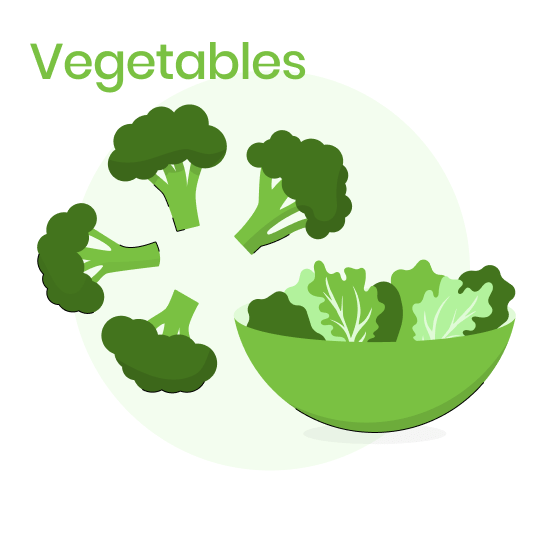
The MyPlate Vegetable Food Group
Since you were a kid, you probably heard about the importance of eating vegetables. But in 2019, only 10% of U.S. adults in a CDC survey met vegetable intake recommendations. Some common barriers to eating fruits and veggies were cost and limited availability and access. If you’re having trouble meeting the recommendations, that’s okay. The first steps are awareness and education, which you’re taking right now by reading this article!

Daily vegetable recommendations
MyPlate says that any vegetable or 100% vegetable juice counts in this group. Let’s face it – there are many ways to eat a vegetable! Veggies come in many different colors, flavors, and textures; they contain vitamins and minerals and are a great source of fiber. These vegetables can be raw or cooked, fresh, frozen, canned, or dried – and whole, cut, or mashed.
According to MyPlate, here’s what counts as 1 cup of vegetables:
- 1 cup of raw or cooked veggies or vegetable juice
- 2 cups of raw leafy salad greens
The MyPlate guidance suggests that the amount of veggies you need daily depends on various factors like age, sex, and weight or whether you are pregnant, but here are the general guidelines for adults:
- For women ages 19-30 years: 2.5 to 3 cups
- For women ages 31 and older: 2 to 3 cups
- For men ages 19-59 years: 3 to 4 cups
- For men 60+ years: 2.5 to 3.5 cups
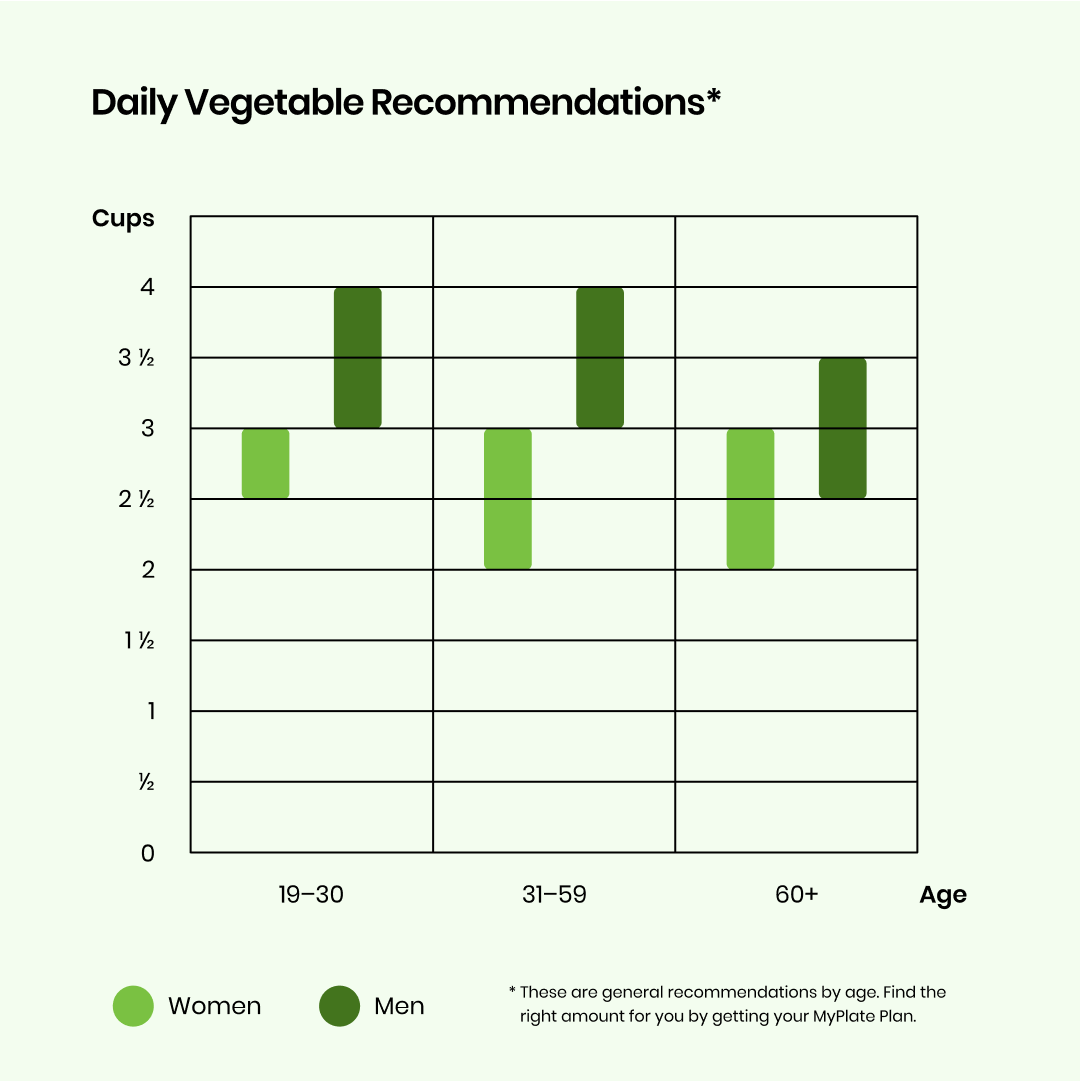
Examples of vegetable servings
MyPlate says there are 5 subgroups of vegetables based on color and which nutrients they provide:
- Dark green vegetables (e.g., broccoli, kale, or mixed greens)
- Red and orange vegetables (e.g., carrots, pumpkin, or tomatoes)
- Beans, peas, and lentils (e.g., garbanzo beans, black-eyed peas or red lentils)
- Starchy vegetables (e.g., white potatoes, plantains, or green peas)
- Other vegetables (e.g., cauliflower, lettuce, or mushrooms)
You may have heard veggies grouped differently than the 5 subgroups. The American Diabetes Association says there are two main groups of vegetables: starchy and non-starchy. Others, like the Cleveland Clinic, sometimes talk specifically about “cruciferous” vegetables, which include dark, leafy greens (such as kale, collard greens) and other colorful veggies in the cabbage family (broccoli, Brussels sprouts, cabbage and cauliflower) packed with nutrients.
If you had to guess, what would you say were the top two vegetables eaten in America? Here’s a clue: think about French fries and pizza sauce! In 2019, potatoes and tomatoes were the most commonly eaten vegetables in the U.S.
The USDA says that these are the top 7 veggies eaten in the U.S. in 2019, listed below with the amount that equals 1 cup according to MyPlate:
Potatoes (Starchy vegetable)
- 1 medium white potato (boiled or baked)
- 1 cup, diced, mashed and fresh or frozen
Tomatoes (Red and Orange vegetable)
- 1 large tomato
- 2 small tomatoes
- 1 cup chopped or sliced, fresh, canned, or cooked
Onions (Other vegetable)
- 1 cup, chopped, raw or cooked
Carrots (Red and Orange vegetable)
- 2 medium carrots
- 1 cup, slices or chopped, fresh, cooked, or frozen
- 1 cup baby carrots
Head Lettuce (Other vegetable)
- 2 cups, raw, shredded, or chopped
Sweet Corn (Starchy vegetable)
- 1 large ear
- 1 cup corn kernels, fresh or frozen
Romaine and Leaf Lettuce (Dark-Green vegetable)
- 2 cups, fresh
According to MyPlate recommendations, fruits and vegetables should be one-half of your plate because of their potential health benefits and vital nutrients like dietary fiber, potassium, folate, vitamin A, and vitamin C.
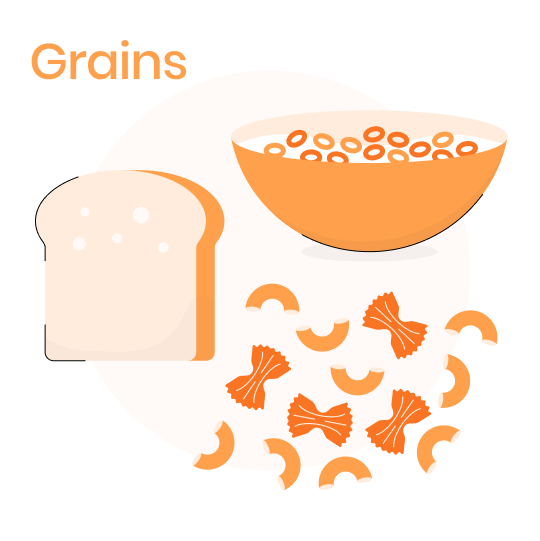
The MyPlate Grains Food Group
Let’s look at MyPlate’s guidance regarding the Grains Food Group. If you were raised in the 90s, you might recall the food pyramid emphasizing grains, which served as its foundation. However, low-carbohydrate diets have gained popularity in recent decades.
Despite the changing opinions, it’s essential to note that MyPlate adheres to the American Dietary Guidelines, 2025-2030, which undergoes a “scientifically rigorous, multi-year process” to make sure it remains up-to-date with the scientific community.
According to MyPlate, the Grains food group includes whole grains and refined grains, but MyPlate recommends that half of your intake should come from whole grains.
The difference between whole and refined grains
Can you explain the distinction between whole and refined grains? Whole grains consist of the entire grain kernel, including the bran, germ, and endosperm. Examples of whole grains include oats and brown rice.
In contrast, refined grains have been milled to remove the bran and germ, leaving only the soft endosperm, which results in a smoother texture. This process reduces the nutritional value of the grain by removing fiber and essential nutrients like B vitamins and iron. MyPlate says that refined grains, like white flour, white bread, or white rice, should be enriched to add back some B vitamins and iron (though the fiber and other plant compounds aren’t added back!).
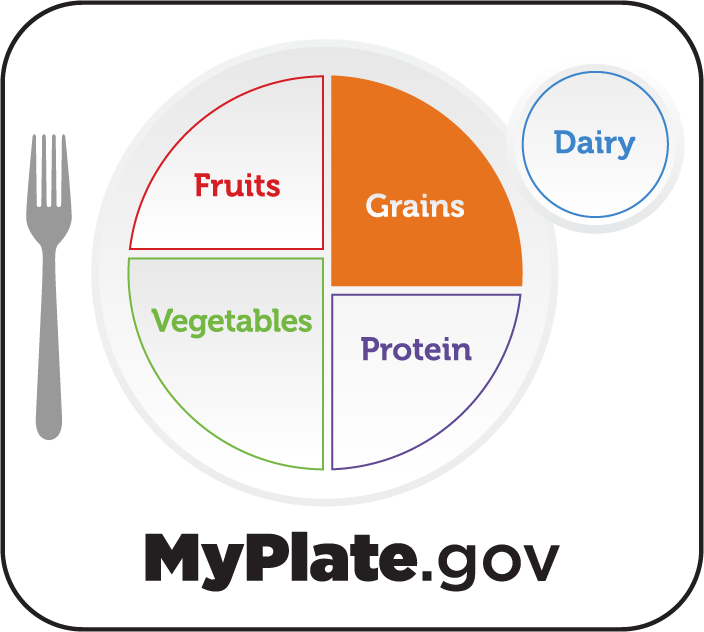
Daily grains recommendations
Let’s take a closer look at daily recommendations for grains. These recommendations are measured in ounces, so to help make it easier to understand, here are some portion sizes that are equivalent to 1 ounce, according to MyPlate:
- 1 bread slice
- 1 cup of ready-to-eat cereal
- 1/2 cup of cooked rice, pasta, or cereal
As it is with the other food groups, daily intake recommendations will vary based on your age, sex, or physical activity, among other factors.
Here are the general MyPlate grain intake recommendations (total grains in ounce-equivalents) for adults (note that the whole grains recommendations will be 50% of the following):
- For women ages 19-30 years: 6 to 8 oz-equiv
- For women ages 31-60+ years: 5 to 7 oz-equiv
- For men ages 19-30 years: 8 to 10 oz-equiv
- For men ages 31-59 years: 7 to 10 oz-equiv
- For men ages 60+ years: 6 to 9 oz-equiv
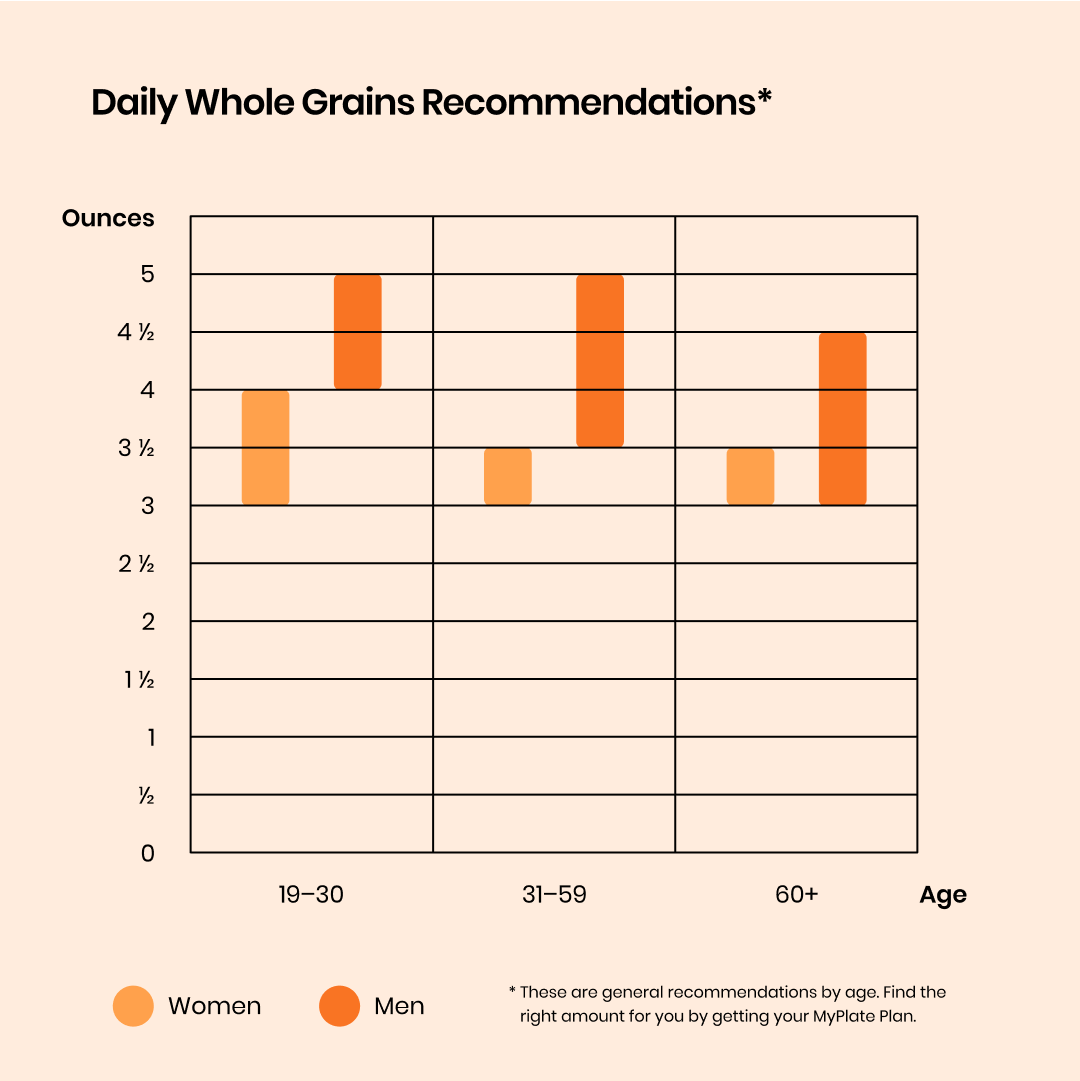
Example of grains servings
As you might guess, the 3 most important food crops in the world are rice, wheat, and corn. Here are some examples of grains from MyPlate and the corresponding amounts that count as 1-ounce-equivalents of grains:
- Bagels: 2″ mini bagel
- Breads: 1 regular slice of bread or 1 small slice of French bread
- Chapati: 1 small chapati or roti (6″)
- Crackers: 5 whole wheat crackers
- English muffins: 1/2 English muffin
- Oatmeal: 1/2 cup cooked, 1 packet instant, or 1oz. dry
- Pasta (spaghetti, macaroni, noodles): 1/2 cup cooked or 1 oz. dry
- Popcorn: 3 cups popped
- Quinoa: 1/2 cup, cooked
- Ready-to-eat breakfast cereal: 1 cup of flakes or rounds or 1.25 cups puffed
- Rice: 1/2 cup cooked or 1 oz. dry
- Tortillas: 1 small flour tortilla (6″ diameter) or 1 corn tortilla (6″ diameter)
Again, the scientific community emphasizes that there are real health benefits when substituting refined-grain products with whole-grain foods like 100% whole-wheat bread, oatmeal, or brown or wild rice. These benefits include helping to regulate weight. The USDA says that people who eat whole grains (as part of a healthy diet) have a reduced risk of some chronic diseases like heart disease – plus, they give us many nutrients vital to our bodies.
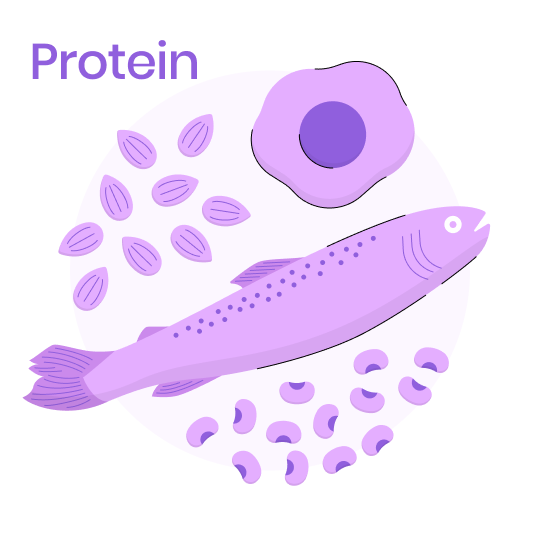
The MyPlate Protein Group
Has a science teacher ever told you that proteins are the building blocks of life? Essentially, you need protein to help your body repair and make new cells and remain in good health. Though most Americans get enough protein in their diets, some groups do not, especially older Americans.
The MyPlate guidance is to “vary your protein routine” so you get more essential nutrients, while any meat or poultry sources should be low-fat or lean.
Note: If you are vegetarian or vegan, the MyPlate advice to eat meat, poultry, or seafood won’t apply to you – but be assured that you can get enough protein as long as the variety and amount of foods you select from the Proteins group are enough. For example, vegans could get protein from beans, peas, and lentils, as well as nuts and seeds, and soy products while vegetarians could get protein from eggs and dairy plus the plant foods listed for vegans.
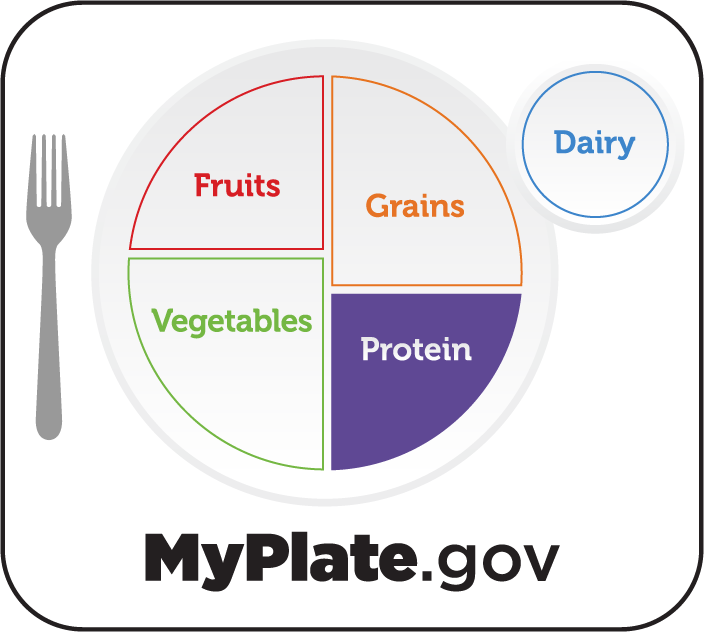
Daily protein recommendations
First, we’ll look at what MyPlate says counts as a 1 ounce-equivalent from the Protein Foods group:
- 1 oz. of meat, poultry, or fish
- 1/4 cup cooked beans
- 1 egg
- 1 tablespoon of peanut butter
- 1/2 ounce of nuts or seeds
As is the case with the other MyPlate Food Groups, your protein needs may vary by age, sex, height, weight, and physical activity, but here are the MyPlate general recommendations for daily protein intake:
- For women ages 19-30 years: 5 to 6.5 oz-equiv
- For women ages 31-60+ years: 5 to 6 oz-equiv
- For men ages 19-30 years: 6.5 to 7 oz-equiv
- For men ages 31-59 years: 6 to 7 oz-equiv
- For men ages 60+ years: 5.5 to 6.5 oz-equiv
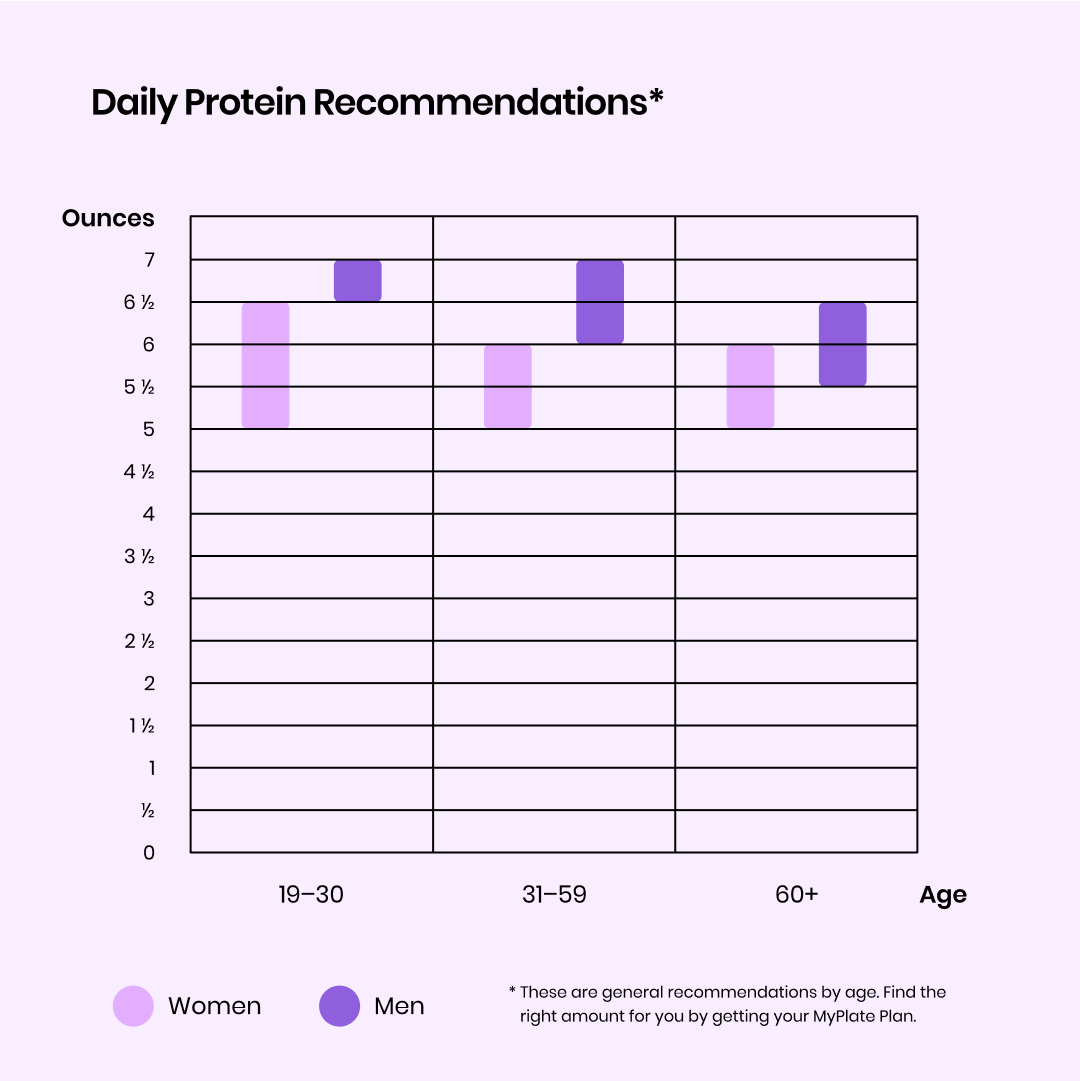
Examples of protein servings
Here are some examples of Protein Foods, broken down by category:
Meat:
- 1 oz. cooked lean beef, lean ground beef, ham, or pork
- 1 slice of deli meats
Poultry:
- 1 oz. cooked chicken (without the skin) or turkey
- 1 sandwich slice of turkey or chicken breast
Seafood:
- 1 oz. of cooked finfish like cod, light tuna, salmon, or halibut
- 1 oz. of cooked shellfish like crab or shrimp
- 1 oz. of canned fish
Eggs:
- 1 egg
- 1 1/2 egg whites
Nuts and seeds:
- 1/2 oz. of nuts (e.g., 12 almonds or 7 walnut halves)
- 1/2 oz. of seeds (e.g. chia or sesame)
- 1 tablespoon of nut butter like almond or peanut butter or tahini
Beans, peas, and lentils:
- 1/4 cup of cooked beans, peas, or lentils (like black beans or garbanzo beans, black-eyed peas or split peas, or red or brown lentils)
- 1/4 cup of baked or refried beans
- 1/4 cup (around 2 oz.) of tofu
- 1 oz. of cooked tempeh
- 1 falafel patty (4 oz)
- 6 tablespoons of hummus
Again, MyPlate encourages variety in the protein foods you eat and consuming lean meats and poultry if you eat meat. MyPlate also notes that though many Americans get enough protein from meat, poultry, and eggs, they don’t meet the recommendations for seafood, nuts, seeds, or soy products. If you can meet these requirements, it will help increase your intake of important nutrients like unsaturated fats, dietary fiber, and vitamin D, as well as limit the sodium and saturated fats from processed meats.

The MyPlate Dairy Food Group
Did you know that the consumption of cow’s milk has been on a steady decline for over 70 years? The data shows that per capita consumption of fluid milk in the United States has been decreasing, especially in recent times. In fact, about 90% of the U.S. doesn’t meet the Dietary Guidelines’ dairy recommendations.
The scientific research on the health benefits of dairy is mixed and can be conflicting, as in this article by Harvard University that examines the scientific literature on dairy. They conclude, however, that dairy foods can be good sources of protein, calcium, B vitamins, and vitamin D. Also, fermented dairy like yogurt and some cheeses may help benefit digestive health. Yet, the article says that the nutrients in milk can be found in other foods.
In this section, we’ll go through the MyPlate daily dairy recommendations and some examples to help you consider ways of adding dairy to your diet. MyPlate advocates for moving to low-fat or fat-free dairy milk or yogurt (or their lactose-free dairy or soy versions).
Note: If you choose not to eat or drink dairy products, know that fortified soy milk and yogurt with added calcium, vitamin A, and vitamin D count as part of the Dairy Group.
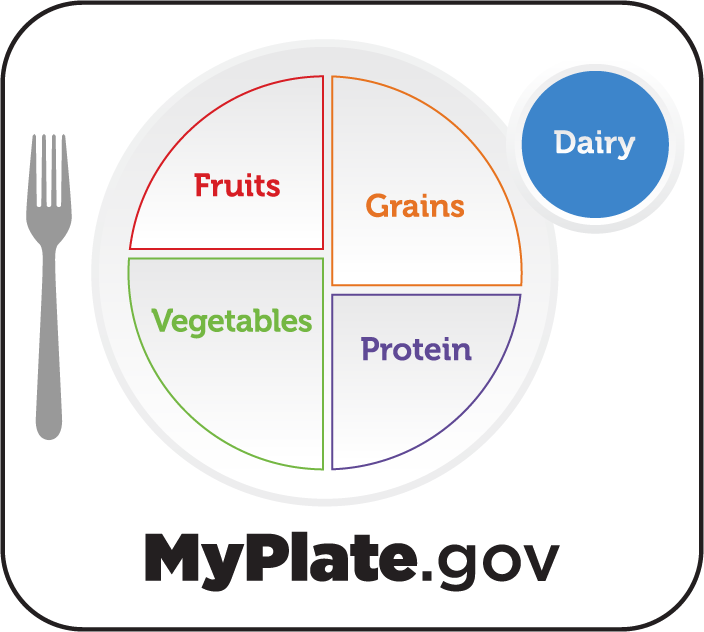
Daily dairy recommendations
According to MyPlate, 1 cup of dairy is generally:
- 1 cup of milk, yogurt, or soy milk
- 1.5 oz. of natural cheese
Of course, the amount of dairy you need will vary by age, sex, height, or physical activity, but here are the MyPlate general recommendations for daily dairy intake:
- For women ages 19-60+ years: 3 cups
- For men ages 19-60+ years: 3 cups
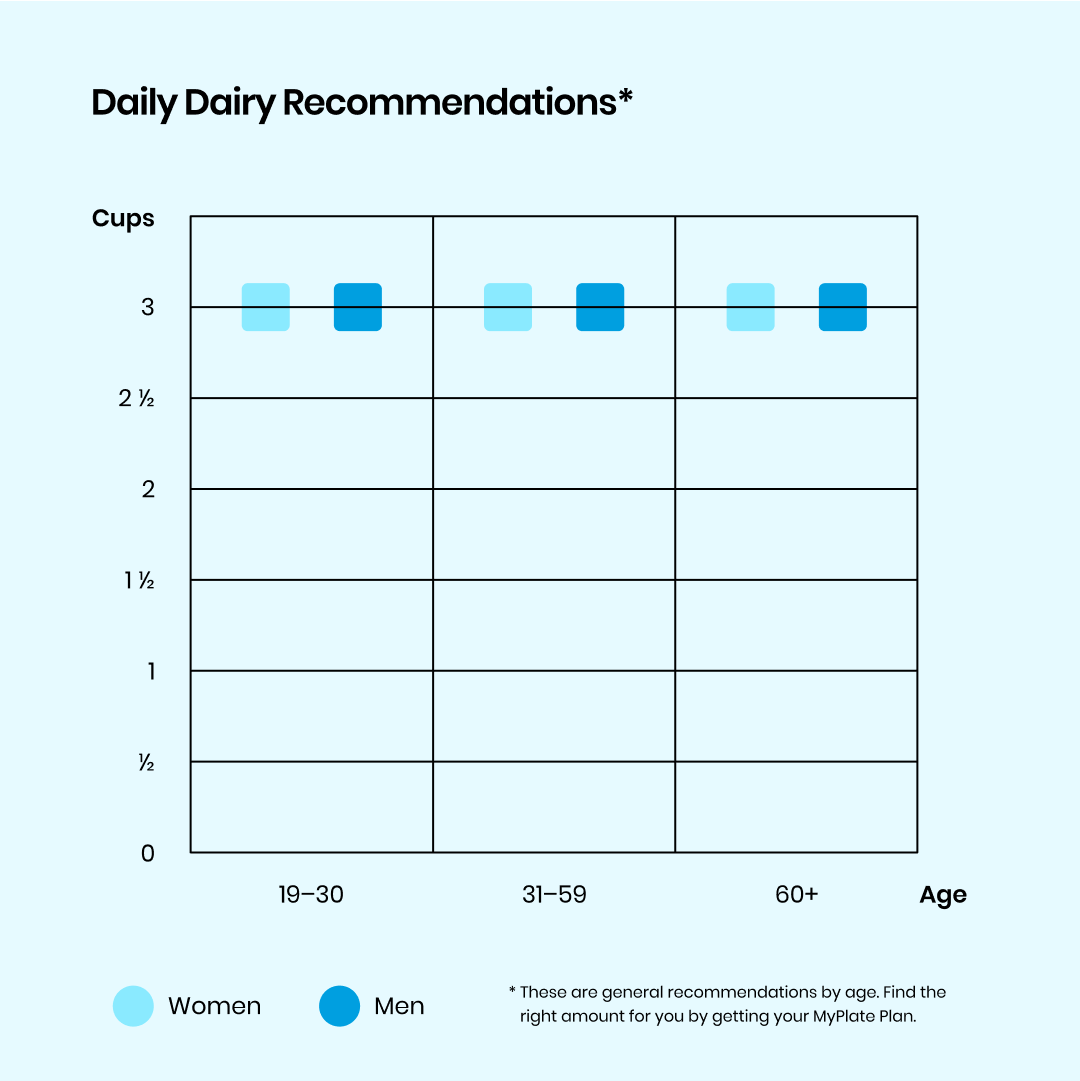
Examples of dairy servings
Here are some examples of dairy products that count as 1 cup:
Milk:
- 1 cup cow’s milk
- 1 cup calcium-fortified soy milk
Yogurt:
- 1 cup yogurt (dairy or fortified soy)
Cheese:
- 1.5 oz. of hard cheese like cheddar or mozzarella
- 1/3 cup shredded cheese
- 2 cups cottage cheese
Fast fact: If you’re wondering if plant-based milks (nondairy alternatives) are good for you, the answer is: It depends. MyPlate says that other products made from plants and sold as “milks” may have calcium, but they aren’t a part of the Dairy Group “because their nutrition content is not like dairy milk and fortified soy milk.”
One societal concern is that producing dairy foods can place a significant demand on the planet’s resources, though projects are underway to inform and improve sustainability. If you can’t or choose not to eat or drink dairy, other options contain calcium, like calcium-fortified juices or milk alternatives, or even canned fish or leafy greens like kale.
How to use MyPlate for portioning meals
Now that we’ve gone through each food group, it’s time to put MyPlate into action. Perhaps the simplest way to portion according to MyPlate guidelines is to make half of your plate a mix of fruits and vegetables, with the other half being grains and proteins.
By highlighting portion sizes and prioritizing plants with more than 3/4 of the plate focused on fruits, vegetables, and grains, MyPlate is a big departure from its controversial predecessor, the Food Pyramid.
Elaine Magee, MPH, RD Wellness Corporate Dietician
In summary, here are the recommended daily servings of each MyPlate food group for people ages 14 and over (based on a daily calorie intake of 2000 calories):
Fruits: 2 cups (e.g., 1 cup from the Fruits group is 1 cup raw or frozen fruit)
Vegetables: 2.5 cups (e.g., 1 cup from the Vegetable group is 1 cup raw or cooked veggies or 2 cups leafy salad greens)
Grains: 6 oz. (e.g. 1 oz from the Grains group is 1 slice of bread or 1/2 cup of cooked rice or pasta)
Protein: 5.5 oz (e.g., 1 oz from the Proteins group is 1 oz. of lean meat, 1 TB of peanut butter, or 1/4 cup cooked beans or lentils)
Dairy: 3 cups (e.g., 1 cup from the Dairy group is 1 cup dairy milk or fortified soy milk, or 1.5 oz. of hard cheese)
Measuring or estimating the portions of different food groups in our meals can be overwhelming. However, many people tend to stick to a set of their favorite meals on repeat. By dividing your favorite meal into the MyPlate food groups, you can avoid the need to measure it again in the future.
For example, you can also measure a favorite bowl and know that it holds about 2 cups. You can fill half the bowl with veggies and split the other half with your grains and protein choice.
Elaine Magee, MPH, RD Wellness Corporate Dietician
Tips on estimating portion size
Did you know you can use your hand or everyday objects to measure portion sizes? Here are some ideas from the National Library of Medicine:
- 1 serving of meat or poultry (3 oz.) is about the size of the palm of your hand or a deck of cards
- 2 tablespoons of peanut butter is a ping-pong ball
- 1/2 cup of cooked rice or pasta is a rounded handful or a tennis ball
- 1 cup of chopped fruits or veggies is a woman’s fist or a baseball
You can use these tips for portioning meals according to MyPlate guidelines.
Benefits of Using MyPlate
If you decide to use MyPlate as a visual for meal planning and helping balance your nutritional intake, then you could experience positive benefits, ranging from positive associations with health to benefits to meal planning and shopping.
The truth is, it’s impossible to create a simple visual symbol/icon that represents all the important components of eating healthy and that takes into account all the different eating styles and food preferences that exist today. But if a picture is worth a thousand words, then the MyPlate symbol is successful in getting the conversation started on balanced, healthy eating.
Elaine Magee, MPH, RD Wellness Corporate Dietician
When creating the current Dietary Guidelines for Americans, the U.S. Department of Agriculture’s Nutrition Evidence Systematic Review team reviewed the existing diet and health research. Ultimately, the evidence suggested that dietary patterns in adults that included a higher consumption of vegetables, fruits, legumes, nuts, whole grains, unsaturated vegetable oils, fish, and lean meat or poultry (if meat was included) were associated with health benefits. MyPlate is an educational tool that grew out of this evidence-based research.
Aside from being evidence-based, studies have shown the real-world benefits of using visual tools like MyPlate. The National Center for Health Statistics (a part of the Centers for Disease Control and Prevention, or CDC) found that from 2017 – March 2020, about 25% of U.S. adults had heard of MyPlate. Those who had heard of MyPlate were more likely to rate their diet as excellent or very good than fair or poor.
Meal planning benefits
One advantage of using MyPlate is that it provides a framework instead of rigid guidelines so you can customize it to the meals that meet your needs. MyPlate tips like “Make half your plate fruits & vegetables” or “Make half your grains whole grains” are intended to be easy to follow.
You can also use the MyPlate framework while shopping for groceries. For example, when shopping in the bread or rice aisles, you can choose whole grains like whole wheat or brown rice. Another example could be choosing lean meats like 93% lean ground beef or low-fat milk.
MyPlate guidelines also include canned or frozen foods in addition to fresh foods – which could be lower-cost in some cases (such as canned tuna or frozen vegetables). They may also be more convenient and last longer than fresh meat or produce.
Limitations of MyPlate
As with any educational public health tool, there will always be ways to improve its effectiveness – and so it is with MyPlate.
One study suggests that using MyPlate alone may not be enough to educate people about food choices. Instead, the guidelines could be complemented with other tools; for example, a tool that gauges the level of food processing in a food item, as “ultra-processed” foods may have poorer nutrition. The authors also point out that many foods may not be easily classified into one MyPlate category because they are combination foods, like pizza.
The meals people typically eat, like pizza, spaghetti, and hamburgers, are difficult to picture falling into the various food groups on the plate diagram. But with some examples and practice, people can envision that while the crust of the pizza falls in the grains plate portion, the protein toppings would fall in the protein plate portion and the cheese in the dairy group. Perhaps the biggest message around pizza is that the other half of the plate ideally would be mostly covered in veggies.
Elaine Magee, MPH, RD Wellness Corporate Dietician
Another study comments on the affordability of MyPlate while estimating the total costs, including food and labor, required to support a MyPlate diet for Supplemental Nutrition Assistance Program (SNAP) recipients. The research found that when you account for meal-prepping time, the current levels of SNAP benefits plus expected personal expenses were not enough to cover the entire cost of supporting a diet recommended by MyPlate. The study also found variation in daily costs of eating fresh, frozen, or canned fruits and veggies – and that consuming 100% of fresh fruits and veggies was the most expensive.
In conclusion
The simplicity of the visual icon of MyPlate and its approach as a framework, not prescriptive guidelines, can make it easier to plan meals and help get the right amount of each of the 5 MyPlate food groups into your diet. With some practice, you’ll be well on your way to pursuing a balanced plate!
The Sincerely Health App empowers users to adopt MyPlate’s daily food group targets, tailored to their unique eating style and preferences. By providing guidance on which food groups to prioritize and limit, users can incorporate healthy habits into their daily routines.

-
1
U.S. Department of Agriculture. (n.d.). Learn How to Eat Healthy With MyPlate. https://www.myplate.gov/
-
2
U.S. Department of Agriculture. (n.d.). Dietary guidelines for Americans. Home | Dietary Guidelines for Americans. https://www.dietaryguidelines.gov/
-
3
Neuman, W. (2011, June 2). Nutrition Plate unveiled, replacing Food Pyramid. The New York Times. https://www.nytimes.com/2011/06/03/business/03plate.html
-
4
United States Department of Agriculture. (n.d.). Fruits. U.S. Forest Service. https://www.fs.usda.gov/wildflowers/ethnobotany/food/fruits.shtml
-
5
Joanne L. Slavin , Beate Lloyd, Health Benefits of Fruits and Vegetables, Advances in Nutrition, Volume 3, Issue 4, July 2012, Pages 506–516. https://doi.org/10.3945/an.112.002154
-
6
U.S. National Library of Medicine. (n.d.). Eat fruit and vegetables, live longer . NIH MedlinePlus Magazine. https://magazine.medlineplus.gov/article/eat-fruit-and-vegetables-live-longer
-
7
U.S. Department of Agriculture. (2023, May 5). Apples and oranges are the top U.S. fruit choices. USDA Economic Research Service. https://www.ers.usda.gov/data-products/chart-gallery/gallery/chart-detail/?chartId=58322
-
8
Harvard T.H. Chan School of Public Health. (2018, August 20). Common questions about fruits and vegetables. The Nutrition Source. https://www.hsph.harvard.edu/nutritionsource/common-questions-fruits-vegetables/
-
9
Lee, S. H., Moore, L. V., Park, S., Harris, D. M., & Blanck, H. M. (2022, January 6). Adults meeting fruit and vegetable intake recommendations - United States, 2019. Morbidity and Mortality Weekly Report. https://www.cdc.gov/mmwr/volumes/71/wr/mm7101a1.htm?s_cid=mm7101a1_w#contribAff
-
10
American Diabetes Association. (n.d.). Non-starchy vegetables. https://diabetes.org/healthy-living/recipes-nutrition/eating-well/non-starchy-vegetables
-
11
Cleveland Clinic. (2023, June 7). What Are Cruciferous Vegetables — and Why Are They So Good for You?. Cleveland Clinic Health Essentials. https://health.clevelandclinic.org/crunchy-and-cruciferous-youll-love-this-special-family-of-veggies/
-
12
U.S. Department of Agriculture. (2020, December 16). Potatoes and tomatoes are the most commonly consumed vegetables. USDA Economic Research Service. https://www.ers.usda.gov/data-products/chart-gallery/gallery/chart-detail/?chartId=58340
-
13
Cleveland, L. E., Cook, A. J., Wilson, J. W., Friday, J. E., Ho, J. W., & Chahil, P. S. (1997, March). Pyramid Servings Data: Results from USDA’s 1994 Continuing Survey of Food Intakes by Individuals. Pyramid Servings Data. https://www.ars.usda.gov/ARSUserFiles/80400530/pdf/Pynet_94.pdf
-
14
U.S. Department of Agriculture. (n.d.). Dietary Guidelines for Americans, 2025-2030 Development Process. Learn About the Process | Dietary Guidelines for Americans. https://www.dietaryguidelines.gov/learn-about-process#step-3-advisory-committee-reviews-scientific-evidence
-
15
Harvard Health Publishing. (2019, November 4). Don’t give up on grains. The Nutrition Source. https://www.hsph.harvard.edu/nutritionsource/what-should-you-eat/whole-grains/
-
16
Awika, J. (2011, November 30). Major cereal grains production and use around the world. ACS Publications. https://pubs.acs.org/doi/10.1021/bk-2011-1089.ch001
-
17
U.S. Department of Agriculture. (2022, November 4). What are the health benefits of eating grains? . askUSDA. https://ask.usda.gov/s/article/What-are-the-health-benefits-of-eating-grains
-
18
U.S. National Library of Medicine. (n.d.). Protein in Diet. MedlinePlus. https://medlineplus.gov/ency/article/002467.htm
-
19
Agency for Healthcare Research and Quality. (2023, June 2). Evaluation of dietary protein intake requirements. Effective Health Care (EHC) Program. https://effectivehealthcare.ahrq.gov/products/dietary-protein-intake/protocol#9
-
20
U.S. Department of Agriculture . (n.d.). Muscle up to some protein every day. USDA ARS AgResearch Magazine. https://tellus.ars.usda.gov/stories/articles/muscle-up-to-some-protein-every-day/
-
21
Huang, J., Liao, L. M., Weinstein, S. J., Sinha, R., Graubard, B. I., & Albanes, D. (2020). Association between plant and animal protein intake and overall and cause-specific mortality. JAMA Internal Medicine, 180(9), 1173. https://doi.org/10.1001/jamainternmed.2020.2790
-
22
U.S. Department of Agriculture. (2022, June 21). Fluid milk consumption continues downward trend, proving difficult to reverse. USDA Economic Research Service. https://www.ers.usda.gov/amber-waves/2022/june/fluid-milk-consumption-continues-downward-trend-proving-difficult-to-reverse/
-
23
Harvard T.H. Chan School of Public Health. (2023, February 2). Dairy. The Nutrition Source. https://www.hsph.harvard.edu/nutritionsource/dairy/
-
24
Mackeen, D. (2021, May 10). Are Plant Milks Good for you?. The New York Times. https://www.nytimes.com/2021/05/10/style/plant-milk.html
-
25
U.S. National Library of Medicine. (Reviewed 2022, July 30). Portion Size. MedlinePlus. https://medlineplus.gov/ency/patientinstructions/000337.htm
-
26
English, L. K., Ard, J. D., Bailey, R. L., Bates, M., Bazzano, L. A., Boushey, C. J., Brown, C., Butera, G., Callahan, E. H., de Jesus, J., Mattes, R. D., Mayer-Davis, E. J., Novotny, R., Obbagy, J. E., Rahavi, E. B., Sabate, J., Snetselaar, L. G., Stoody, E. E., Van Horn, L. V., … Heymsfield, S. B. (2021). Evaluation of dietary patterns and all-cause mortality. JAMA Network Open, 4(8). https://doi.org/10.1001/jamanetworkopen.2021.22277
-
27
Wambogo E, Ansai N, Wang C, Terry A, Fryar C, Ahluwalia N, Ogden CL. Awareness of the MyPlate plan: United States, 2017–March 2020. National Health Statistics Reports; no 178. Hyattsville, MD: National Center for Health Statistics. 2022. DOI: https://dx.doi.org/10.15620/cdc:121629
-
28
Nazmi, A., Tseng, M., Robinson, D., Neill, D., & Walker, J. (2019). A nutrition education intervention using NOVA is more effective than MyPlate Alone: A proof-of-concept randomized controlled trial. Nutrients, 11(12), 2965. https://doi.org/10.3390/nu11122965














